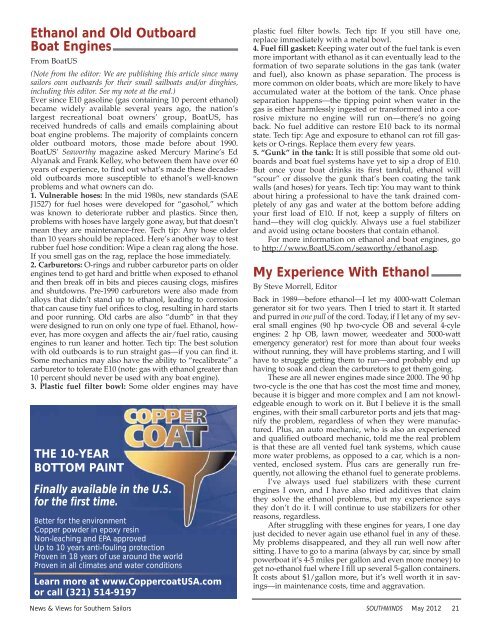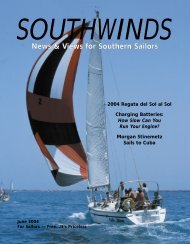News & Views for Southern Sailors - Southwinds Magazine
News & Views for Southern Sailors - Southwinds Magazine
News & Views for Southern Sailors - Southwinds Magazine
- No tags were found...
Create successful ePaper yourself
Turn your PDF publications into a flip-book with our unique Google optimized e-Paper software.
Ethanol and Old OutboardBoat EnginesFrom BoatUS(Note from the editor: We are publishing this article since manysailors own outboards <strong>for</strong> their small sailboats and/or dinghies,including this editor. See my note at the end.)Ever since E10 gasoline (gas containing 10 percent ethanol)became widely available several years ago, the nation’slargest recreational boat owners’ group, BoatUS, hasreceived hundreds of calls and emails complaining aboutboat engine problems. The majority of complaints concernolder outboard motors, those made be<strong>for</strong>e about 1990.BoatUS’ Seaworthy magazine asked Mercury Marine’s EdAlyanak and Frank Kelley, who between them have over 60years of experience, to find out what’s made these decadesoldoutboards more susceptible to ethanol’s well-knownproblems and what owners can do.1. Vulnerable hoses: In the mid 1980s, new standards (SAEJ1527) <strong>for</strong> fuel hoses were developed <strong>for</strong> “gasohol,” whichwas known to deteriorate rubber and plastics. Since then,problems with hoses have largely gone away, but that doesn’tmean they are maintenance-free. Tech tip: Any hose olderthan 10 years should be replaced. Here’s another way to testrubber fuel hose condition: Wipe a clean rag along the hose.If you smell gas on the rag, replace the hose immediately.2. Carburetors: O-rings and rubber carburetor parts on olderengines tend to get hard and brittle when exposed to ethanoland then break off in bits and pieces causing clogs, misfiresand shutdowns. Pre-1990 carburetors were also made fromalloys that didn’t stand up to ethanol, leading to corrosionthat can cause tiny fuel orifices to clog, resulting in hard startsand poor running. Old carbs are also “dumb” in that theywere designed to run on only one type of fuel. Ethanol, however,has more oxygen and affects the air/fuel ratio, causingengines to run leaner and hotter. Tech tip: The best solutionwith old outboards is to run straight gas—if you can find it.Some mechanics may also have the ability to “recalibrate” acarburetor to tolerate E10 (note: gas with ethanol greater than10 percent should never be used with any boat engine).3. Plastic fuel filter bowl: Some older engines may haveTHE 10-YEARBOTTOM PAINTFinally available in the U.S.<strong>for</strong> the first time.Better <strong>for</strong> the environmentCopper powder in epoxy resinNon-leaching and EPA approvedUp to 10 years anti-fouling protectionProven in 18 years of use around the worldProven in all climates and water conditionsLearn more at www.CoppercoatUSA.comor call (321) 514-9197plastic fuel filter bowls. Tech tip: If you still have one,replace immediately with a metal bowl.4. Fuel fill gasket: Keeping water out of the fuel tank is evenmore important with ethanol as it can eventually lead to the<strong>for</strong>mation of two separate solutions in the gas tank (waterand fuel), also known as phase separation. The process ismore common on older boats, which are more likely to haveaccumulated water at the bottom of the tank. Once phaseseparation happens—the tipping point when water in thegas is either harmlessly ingested or trans<strong>for</strong>med into a corrosivemixture no engine will run on—there’s no goingback. No fuel additive can restore E10 back to its normalstate. Tech tip: Age and exposure to ethanol can rot fill gasketsor O-rings. Replace them every few years.5. “Gunk” in the tank: It is still possible that some old outboardsand boat fuel systems have yet to sip a drop of E10.But once your boat drinks its first tankful, ethanol will“scour” or dissolve the gunk that’s been coating the tankwalls (and hoses) <strong>for</strong> years. Tech tip: You may want to thinkabout hiring a professional to have the tank drained completelyof any gas and water at the bottom be<strong>for</strong>e addingyour first load of E10. If not, keep a supply of filters onhand—they will clog quickly. Always use a fuel stabilizerand avoid using octane boosters that contain ethanol.For more in<strong>for</strong>mation on ethanol and boat engines, goto http://www.BoatUS.com/seaworthy/ethanol.asp.My Experience With EthanolBy Steve Morrell, EditorBack in 1989—be<strong>for</strong>e ethanol—I let my 4000-watt Colemangenerator sit <strong>for</strong> two years. Then I tried to start it. It startedand purred in one pull of the cord. Today, if I let any of my severalsmall engines (90 hp two-cycle OB and several 4-cyleengines: 2 hp OB, lawn mower, weedeater and 5000-wattemergency generator) rest <strong>for</strong> more than about four weekswithout running, they will have problems starting, and I willhave to struggle getting them to run—and probably end uphaving to soak and clean the carburetors to get them going.These are all newer engines made since 2000. The 90 hptwo-cycle is the one that has cost the most time and money,because it is bigger and more complex and I am not knowledgeableenough to work on it. But I believe it is the smallengines, with their small carburetor ports and jets that magnifythe problem, regardless of when they were manufactured.Plus, an auto mechanic, who is also an experiencedand qualified outboard mechanic, told me the real problemis that these are all vented fuel tank systems, which causemore water problems, as opposed to a car, which is a nonvented,enclosed system. Plus cars are generally run frequently,not allowing the ethanol fuel to generate problems.I’ve always used fuel stabilizers with these currentengines I own, and I have also tried additives that claimthey solve the ethanol problems, but my experience saysthey don’t do it. I will continue to use stabilizers <strong>for</strong> otherreasons, regardless.After struggling with these engines <strong>for</strong> years, I one dayjust decided to never again use ethanol fuel in any of these.My problems disappeared, and they all run well now aftersitting. I have to go to a marina (always by car, since by smallpowerboat it’s 4-5 miles per gallon and even more money) toget no-ethanol fuel where I fill up several 5-gallon containers.It costs about $1/gallon more, but it’s well worth it in savings—inmaintenance costs, time and aggravation.<strong>News</strong> & <strong>Views</strong> <strong>for</strong> <strong>Southern</strong> <strong>Sailors</strong> SOUTHWINDS May 2012 21
















